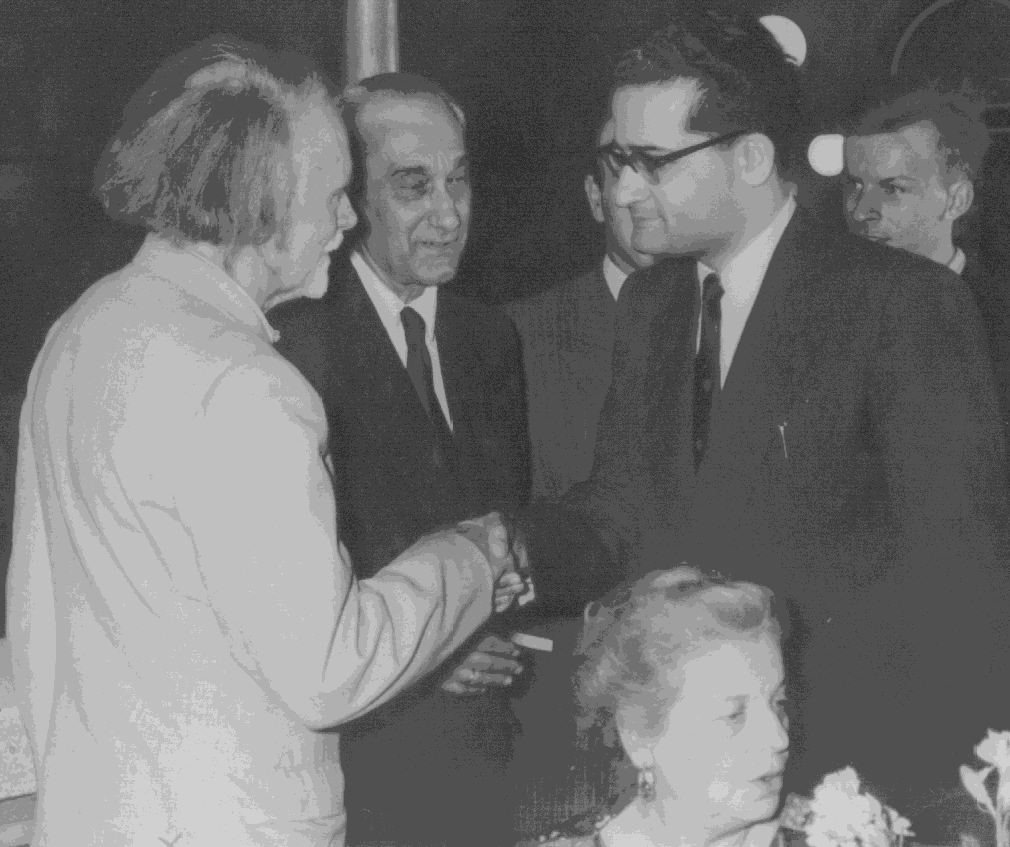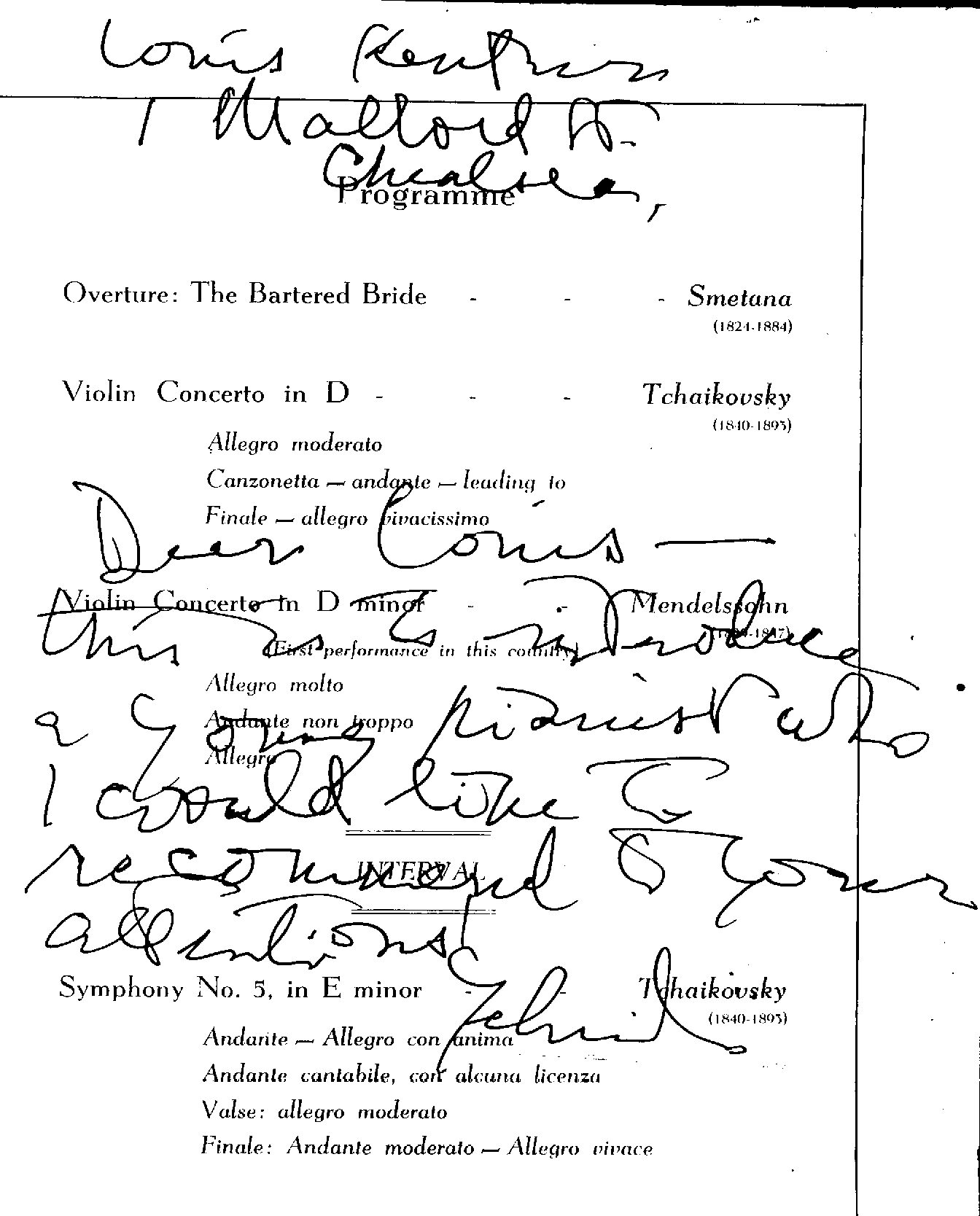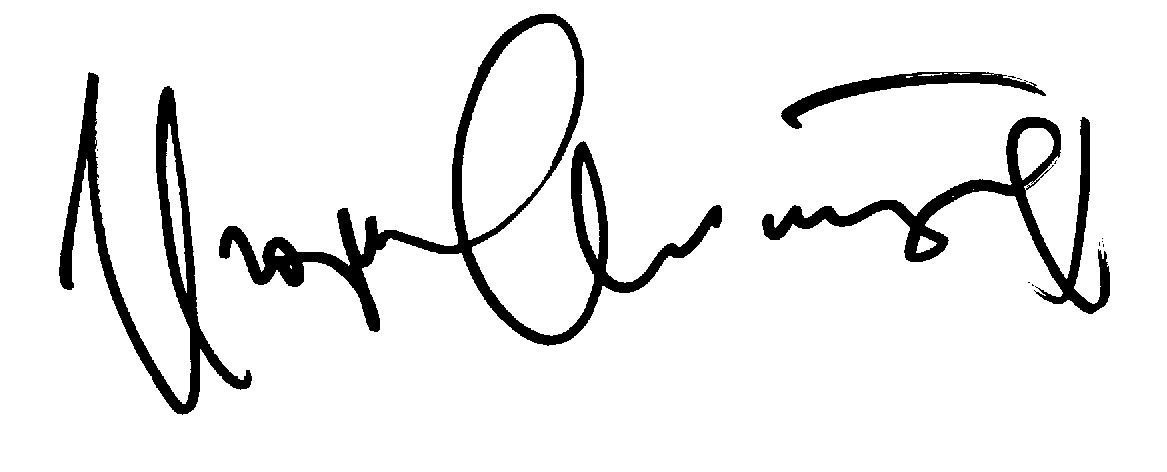Musicians |
extraordinaires | |
ARAM KHATCHATURIAN later in life YEHUDI MENUHIN DAVID OISTRAKH |
Aram
Khatchaturian (1956) The Liszt-Bartók Music Festival 1956 at Budapest had attracted a large number of musical personalities from outside Hungary, and among them was the famous Armenian composer, Aram Khatchaturian, who was staying at the Nagy Szallo on Margaret Island. The Island is romantically situated in the middle of the River Danube between Buda and Pest - those two contrasting cities which were united a hundred years earlier to form the capital of Hungary.
On a balmy September evening, I crossed over
from Pest to the Island, which was bedecked with festive lights and stood out clearly
against the darkening hills of Buda. I could ill conceal my excitement at the
prospect of meeting the composer of the Sabre Dance at a reception given by the
Composers' Union in the ballroom of the Grand Hotel. Considered by many to stand
shoulder-to-shoulder with Shostakovich and Prokofiev as the foremost composers of the
twentieth century, Khatchaturian on first meeting disarmed one with his utter disregard of
protocol and sincerity of purpose. He made no bones about his humble origin as the
son of a poor artisan from Tiflis - who appears to have supported himself by doing
bookbinding - and spoke glowingly of the sterling work done by the Union of Soviet
Composers, both during and after the war, for creative artists like him. To quote
him: Despite his 53 years of age, Khatchaturian - with his shock of dark hair, well-defined eyebrows, prominent nose and full lips - gave one the impression of being a successful businessman in his mid-forties. But, anon, one became aware of his large, expressive eyes, which seemed to look through and beyond his audience, and hinted of the ever-present nostalgia for his native Armenia, the folk-music of which had so profoundly stirred him as a child. Khatchaturian's first work to become universally known was the Trio for clarinet, violin and piano that he had composed as early as 1932: it has an intriguing Transcaucasian atmosphere, and concludes with a movement based on a charming Uzbek folk-song. Then, following his First Symphony, written in the same year to commemorate the fifteenth anniversary of Soviet Armenia, he composed his First Piano Concerto in 1935: it was hailed as a notable event in Soviet music and aroused considerable attention in the West because of its exotic oriental personality. In England it was not heard until Moura Lympany played it at Queen's Hall on April the 13th, 1940. Needless to say, Khatchaturian burgeoned as a consummate composer over the intervening years, and his brilliant Violin Concerto of 1938, the two Gayane Ballet Suites of 1942 along with his Second Symphony, the Masquerade Suite of 1944, and the Cello Concerto and Russian Fantasy of 1946, are some major examples of his musical outpouring as a highly individual, stylistic and forceful innovator. Zoltán Kodály -
the Grand Old Man of Hungarian Music (1956)
Pacing the narrow confines of a special studio in the heart of the Radio Station in Budapest, I struggled to memorise a litany of factual data on the Grand Old Man of Hungarian music, whom I was to meet at some length in a matter of minutes. The inexorable ticking of the clock was a far cry from the romantic chimes of that famous Musical Clock standing in front of the Imperial Palace in Vienna that had inspired Zoltán Kodály to write some of the finest pages of his operatic score to Hary Janos. Nevertheless, this very anachronism triggered off a train of thoughts in my mind on the long and fruitful life of Hungary's major music personality, who was at once teacher, music critic, musicologist and composer. I had already visited a junior school, Leorei Klare, in the suburbs, where Kodály's system of music education was being taught through the media of singing classes and the application of his unique method of sight-reading based on hand signals by Miss Ilona Andor. Kodály's intensive researches into Hungarian folk music in collaboration with Bartók were reflected in his compositions, which deserted his early Brahmsian style for a more national Hungarian identity. Then, suddenly, the door opened, and there he was as I still remember him - a spry elderly gentleman of aristocratic mien with flowing Lisztian hair and white goatee beard. He breezed into the studio looking for all the world like a country squire, who had dropped in on his neighbour for tea. His kindly twinkling eyes put me at ease immediately, and thereupon a firm handshake, belying his venerable age of 70 years, set the seal of cordiality on the afternoon's proceedings. At the Musical Academy, I had that very week heard his youthful piano trio à la Brahms, and an impressionistic piano piece entitled Meditation with a strong Debussyan flavour. But, when I wanted to use these early compositions as points of reference in his musical development, he gently brushed them aside with an apologetic gesture, and ignoring the interpreter launched in broken but emphatic English into an enthusiastic dissertation of his one and only symphony, still in the making: he had mulled over it for many years, and at the time had completed two movements. He was to experience several tragic events, including his own serious illness, before writing the third movement in his 79th year. Stepping back into time, and now using his native Hungarian, Kodály spoke of his great love of Nepdal or Folksong, which was the well-spring of his most creative works - the Concerto for Orchestra and Variations on a Hungarian Folksong, both of 1939; the orchestral Dances of Galanta and Marosszek of the early 1930's; and above all, his famous opera Hary Janos of 1925 and Psalmus Hungaricus of 1923. While it is true to say that he liberated himself from the influence of Brahms as early as 1906 with his Summer Evening for orchestra, it was only in the 1920's that he attained the height of his powers as the voice of Hungary in music - a voice, which despite many vicissitudes was not to be stilled till his death in 1967. With the interview almost over, I asked Kodály what he thought of the great Ferenc Liszt as a Hungarian composer, to which he reparteed: "Hungarian composer? He couldn't even speak the language!" And with that Parthian shot, he stalked out. Yehudi Menuhin I first met him in Calcutta, India, when as a youngster I was just about to return to London for higher studies in December 1951. He was in the midst of a series of concerts, the proceeds of which were meant to go towards the purchase of five Bösendorfer grand pianos - one each for the five major cities of the sub-continent, Calcutta, Delhi, Bombay, Madras and Bangalore. Ever the one to help where he could, Mr. Menuhin found time to turn his attention to me and was gracious enough to scribble a recommendation - on the programme page of his Calcutta concert! - to his brother-in-law, the well-known pianist, Louis Kentner.
Be it said that Mr. Menuhin accomplished his self-appointed fundraising task with aplomb and grace and was fêted everywhere he travelled in that vast country - by the exalted Prime Minister, Jawaharlal Nehru, down to the most humble concert-hall manager. My next meeting with Mr. Menuhin was in Bucharest, Rumania, at a post-concert reception that was held immediately after his performance with the redoubtable David Oistrakh of Bach's Double Violin Concerto. I never met Mr. Oistrakh again, but after his death several years later I had the pleasure of hosting his son, Igor, in Calcutta (of which more below). At the concert itself, Menuhin, who three decades earlier had been the most outstanding pupil of Enesco, was without doubt the darling of the Festival audiences and at his own recital he played his guru's third and last sonata for violin and piano with moving eloquence and impassioned phrasing. I did have the opportunity of meeting Mr. Menuhin once more in the early 1970's in Miami, Florida: he was in the city to perform at one of the popular winter concert series; the years between had aged him and his solo-playing in the concerto was tentative at best. What a let-down after hearing him as the equal - if not the superior - partner of the mighty Oistrakh in Bucharest! But that was by no means the end of the great musician's career. When most people of his age would have been thinking of retirement, Mr. Menuhin swapped the bow for the baton in an increasing number of concerts, and was highly acclaimed for his orchestral interpretations from his new vantage point - the conductor's podium. A few days after celebrating his 82nd birthday, Lord Menuhin (honoured recently by the Queen of England with a life peerage) was interviewed on April 24, 1998 by Charlie Rose of the local PBS station in New York. When Mr. Rose asked, "Do you think, as some have suggested....that you peaked when you were a very young man, that you hit your best a long time ago...(?)", his guest (looking at least 10 years younger than his age would have led a viewer to believe) responded, "I think there were, certainly, ups and downs. I wouldn't necessarily say that I peaked and then consistently un-peaked (!)" Mr. Rose pursued the matter further: "When do you think you were your best...as a violinist?", to which Lord Menuhin replied: "I would say, with some exceptions, up to about 20, 15 years ago. But of course, there will be...exceptions." (Rose Communications) David Oistrakh -
The Compleat Violinist I shall always cherish this chance meeting with Mr. Oistrakh: characteristic of his becoming modesty he preferred at first to talk of the violinistic prowess of his son, Igor, rather than his own, and then - switching the subject - of his anticipated pleasure at appearing with Yehudi Menuhin in Bach's Double Violin Concerto under the baton of Sir John Barbirolli. It is a measure of the greatness of Bach's music and its two renowned exponents that the performance should have been such a sensational success at the circular Athenaeum Hall in Bucharest. The friendship between the two violin virtuosi had sprung up two years earlier when they discovered a bond of mutual interest dear to their hearts - the reconciliation through music of Russia and the West. In 1962, they again shared a concert, this time at the Royal Albert Hall in London: after playing Bach's Double Violin Concerto together, they went onto the Beethoven Concerto (Conductor: Menuhin; Soloist: Oistrakh) and the Brahms Concerto (with the roles reversed). Critics waxed lyrical over Oistrakh as soloist ("lovingly detailed performance"), but drew attention to his "authoritative control" as conductor. Another riveting musical event in London took place in September 1968, when the Moscow Philharmonic Orchestra under the baton of Kyril Kondrashin brought Menuhin together with both David and Igor Oistrakh. Father and son, with the former as violinist, played Mozart's Sinfonia Concertante with Menuhin's conducting. Then, David Oistrakh conducted the orchestra in the Beethoven Concerto with Menuhin as soloist, and to cap it all the three violinists extraordinaires appeared together in Vivaldi's Concerto for Three Violins - with Kondrashin's dignity as conductor restored! It was only last winter (1973), when Calcutta had the honour of hosting Igor Oistrakh, that one learnt of his father's indifferent health, which had given cause for worldwide concern. Nevertheless, despite his then 65 years of age he kept up a taxing concert schedule till the end came in Amsterdam a week ago. Great violinists have always been a rare commodity, yet it is significant that in recent years the Russians have produced some of the most outstanding. And of these, David Oistrakh was undoubtedly the greatest. Wherever he played, connoisseurs were unanimous in their acclaim of his phenomenal assurance, which enabled him to master the most awesome technical difficulty His tone was powerful, eloquent and extremely flexible. And he was equally at home in interpreting the classics and the moderns. His versatility was such that, like Paganini, he also played the viola, which from a violinist's point of view is a dangerous instrument unless he is a "rara avis", who regards technical brilliance as secondary to the pleasure of participating in as much great music as possible. Igor Oistrakh
(December 1973) At first, his art stood in the shadow of his celebrated father, and indeed his early successes were said to have owed something to his famous name. Not so any longer, for through his brilliant virtuosity and sensitive musicianship he has convinced the world of his individuality as a supreme artist. When interviewed (in the VIP lounge of Dum Dum International Airport) by me in my capacity as the Honorary Concert Manager and a Trustee on the Board of The Calcutta School of Music (co-sponsors with the Indian Council of Cultural Relations of the recital in Calcutta at the Kala Mandir), the distinguished visitor spoke of his catholic taste in music: it included performances of works by Bach and Bartok, Schumann and Schubert, Brahms and Beethoven, as well as Hindemith, Prokofiev and Shostakovich. Due to his heavy concert-cum-teaching schedule, Igor Oistrakh said he found little time these days for duo work with his father. Furthermore, the latter had been seriously ill, making the chances of future tie-ups somewhat slim. Mr. Oistrakh is married to a pianist, who often accompanies him in violin and piano works. They have a son, Valeri, who at the age of 12 is already showing signs of following in his father's footsteps. When Igor was 6 years old he was considered a "lazy boy" at his violin studies, and was therefore made to do a stint at piano lessons for some three years before finally reverting to his first love. For Russia - and the rest of the musical world - any other decision would have been a calamity! His large concerto repertoire comprises, as he says, of works he likes to play, but the violin concertos he likes best are those of Tchaikovsky, Sibelius, Brahms, Schumann and Bartok. He also performed trios with Pablo Casals when the world's foremost cellist was 89, and in his view, Pau was without doubt the greatest musician of his age. Igor Oistrakh last paid a visit to India in 1960 when he confined his recitals to Bombay (now known as Mumbai) and Poona (now known as Pune). This second visit takes in the three big metropolitan cities and according to him will give him greater scope to indulge in his chief hobby of colour photography. He described as wonderful the long history of art in India, and while expressing the inadequacy of his knowledge of Indian music he found the sitar fascinating and colourful. In that context, he stated that music should reach out to the masses with a human message, not the way of modern music in the West that has got enmeshed in its own technicalities. On a personal note, I still recall the contretemps that occurred when Igor arrived at our house for the post-recital reception, which was attended by the musical elite of Calcutta. I went out to receive him under the porch and saw him trying to lug his violin-case out of the back-seat of the car. Gallantly, I offered to help, grabbed the leather strap-holder and slung the case around my left shoulder. Only then did I discover that that was no ordinary violin-case: it weighed half-a-ton -- and dislocated my left collar-bone! (We made up later on - as one can see from the photo here!)
Apparently, the precious Stradivarius encased inside needed the type of protection that no ordinary case could offer, so Igor's mentors back in Moscow used solid steel reinforcements to achieve break-proof security of his valuable instrument on peripatetic international tours by land, sea and air.
|








